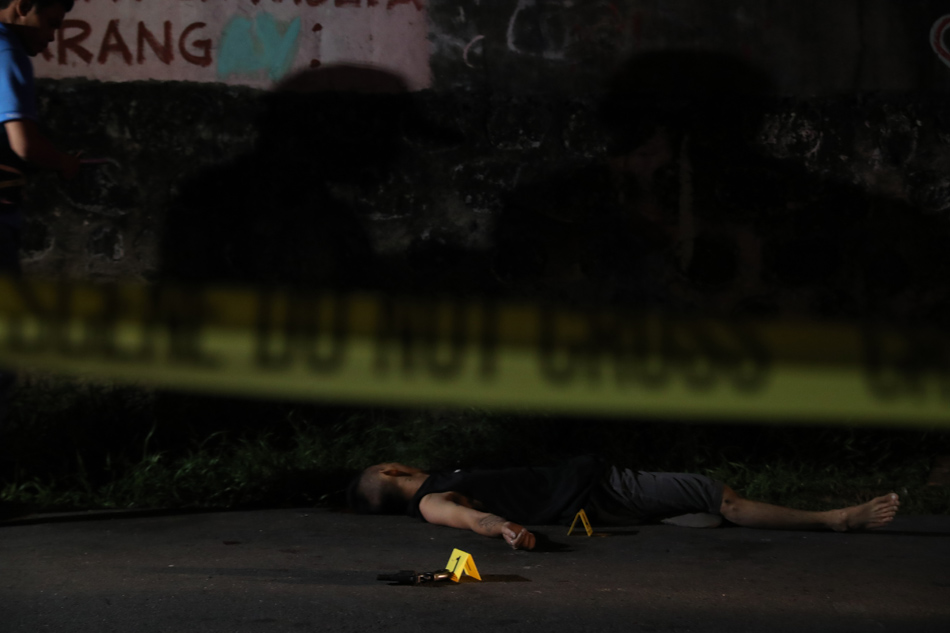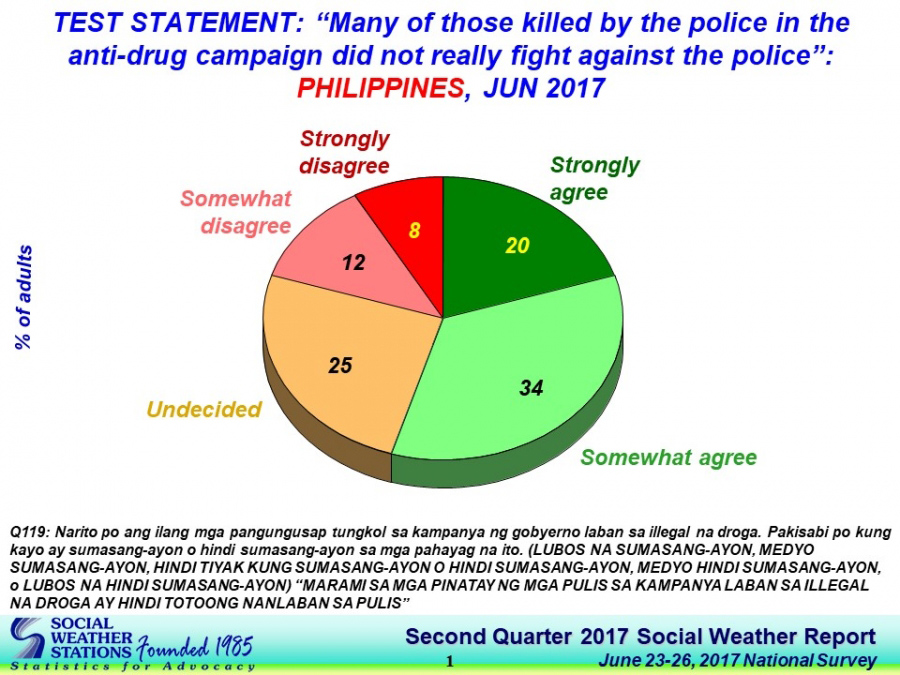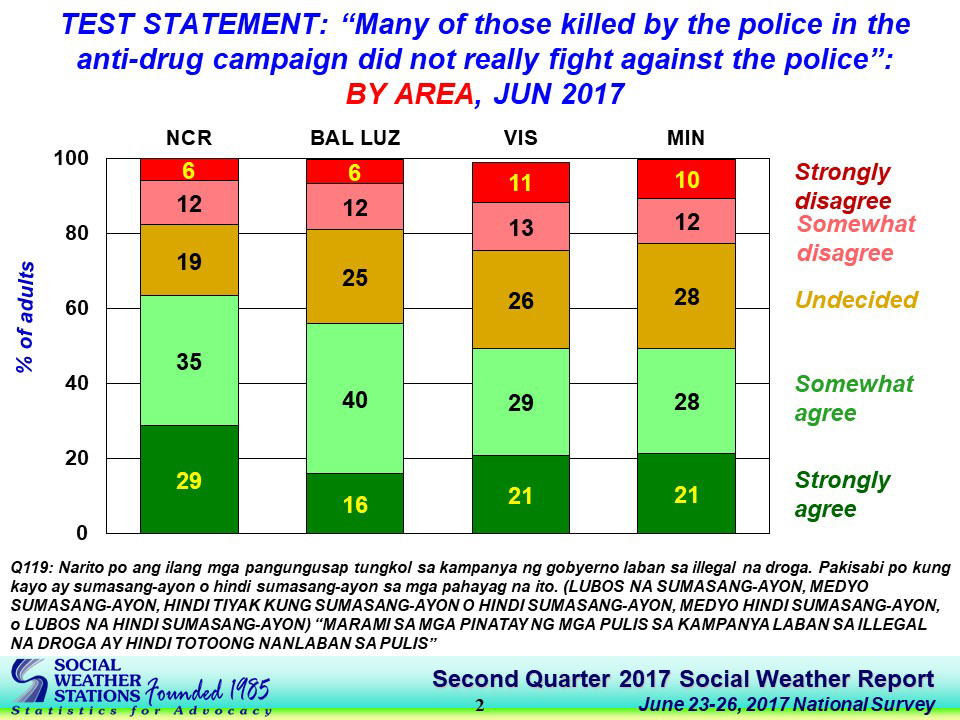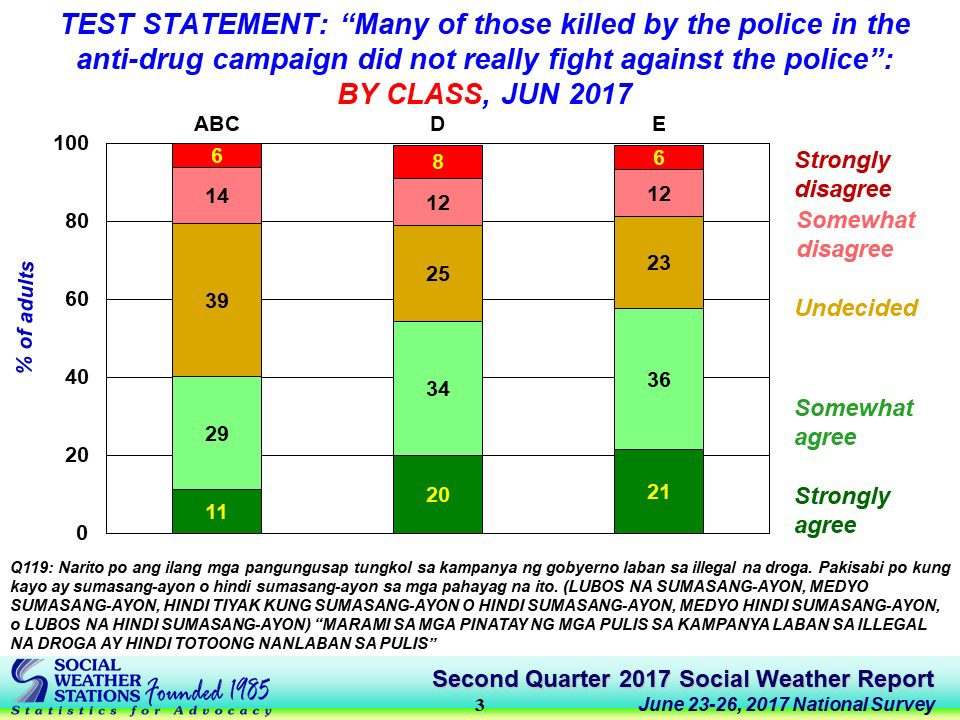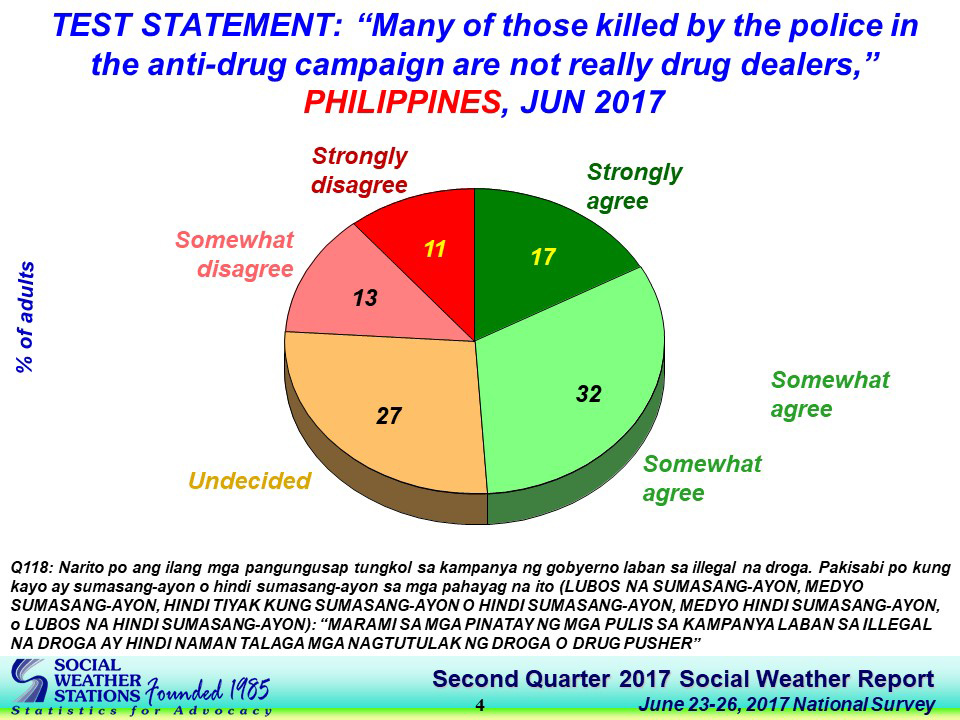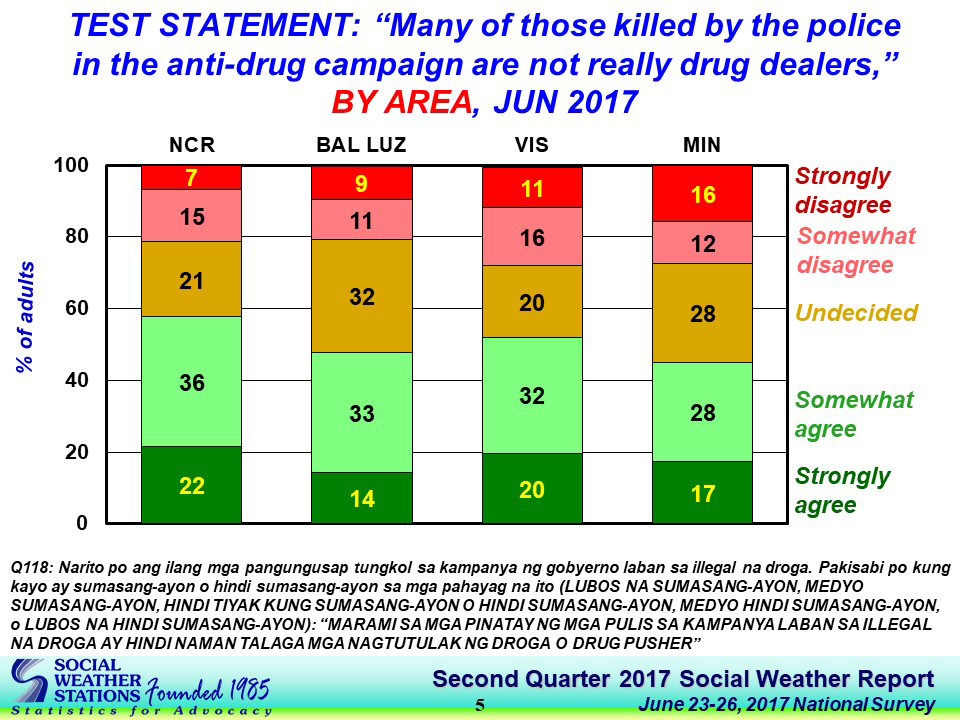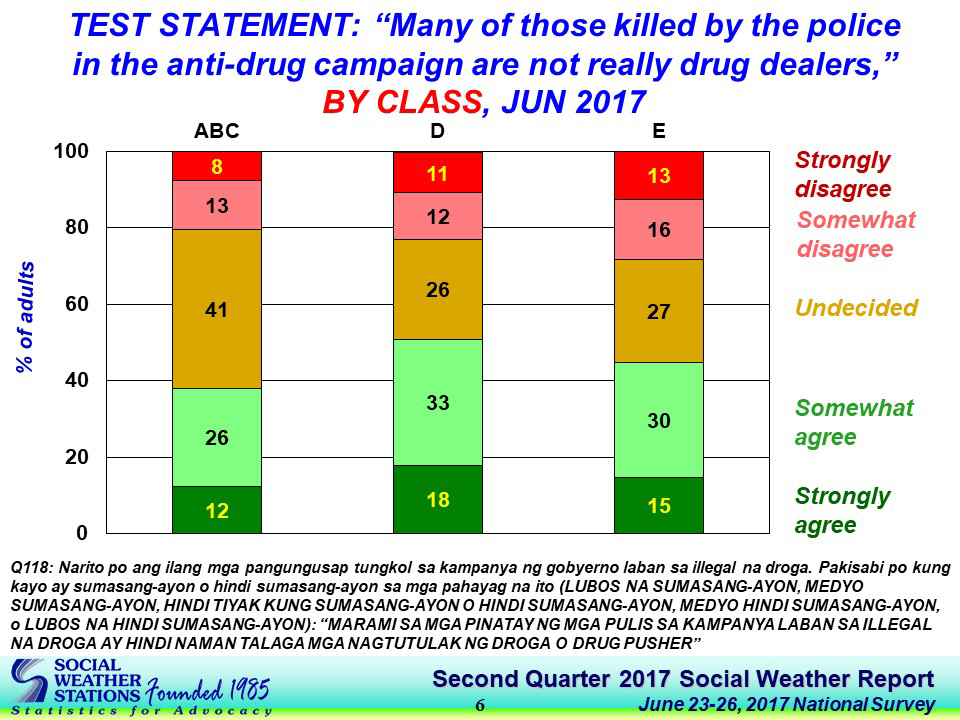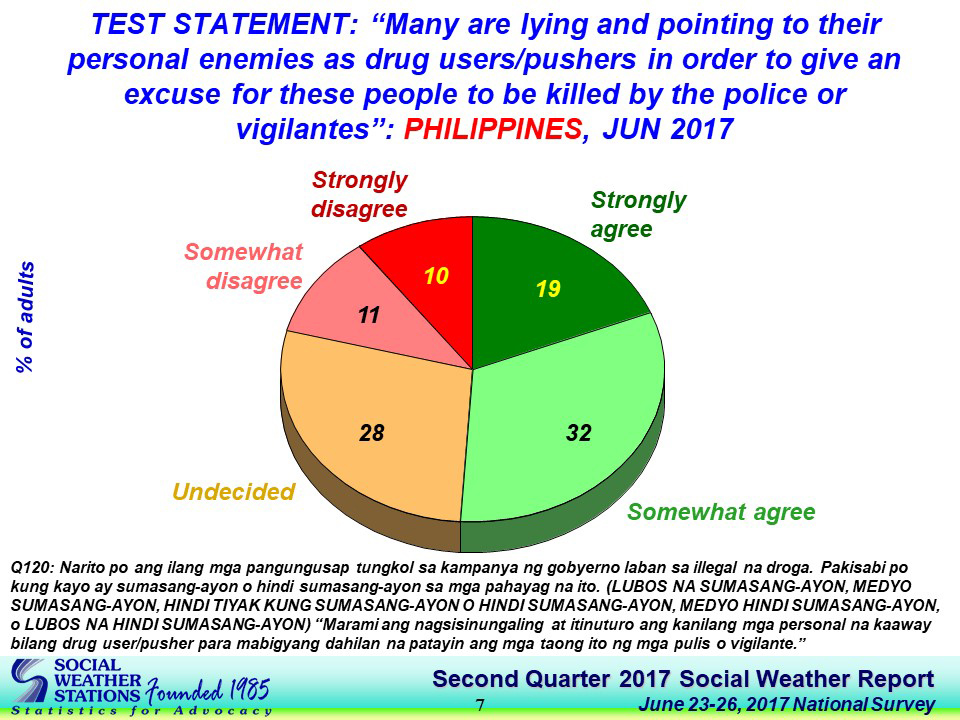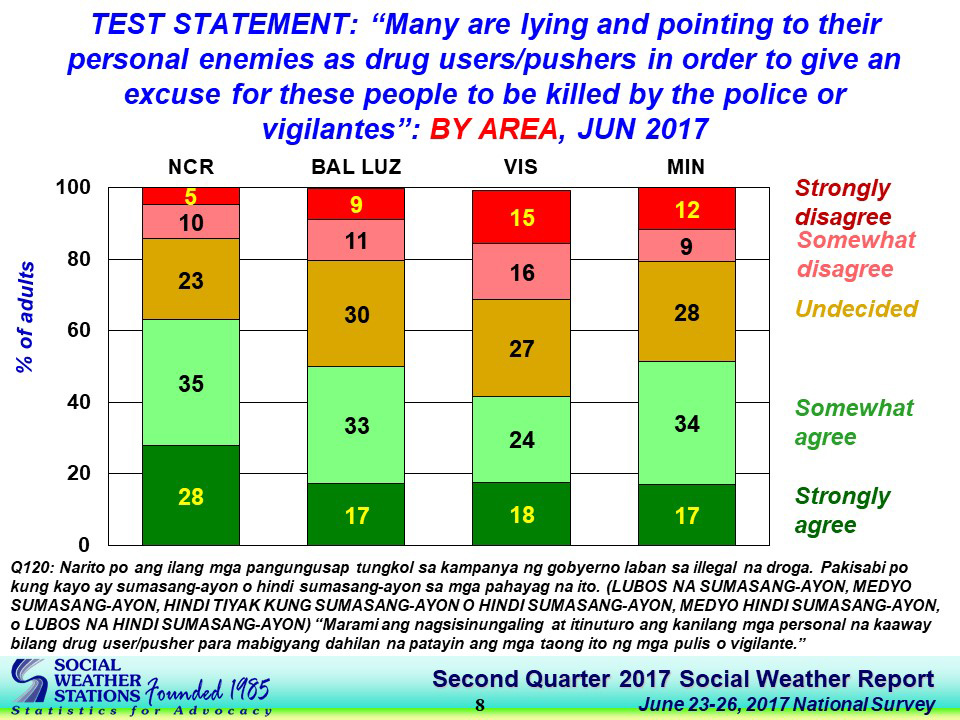Nanlaban? Most Pinoys doubt police account of drug killings, says SWS | ABS-CBN
ADVERTISEMENT

Welcome, Kapamilya! We use cookies to improve your browsing experience. Continuing to use this site means you agree to our use of cookies. Tell me more!
Nanlaban? Most Pinoys doubt police account of drug killings, says SWS
Nanlaban? Most Pinoys doubt police account of drug killings, says SWS
Arianne Merez,
ABS-CBN News
Published Sep 27, 2017 04:35 PM PHT
|
Updated Sep 27, 2017 04:53 PM PHT
MANILA- More than half of Filipinos have expressed doubt that many of those killed in anti-drug operations fought it out with cops, results of a Social Weather Survey (SWS) showed.
MANILA- More than half of Filipinos have expressed doubt that many of those killed in anti-drug operations fought it out with cops, results of a Social Weather Survey (SWS) showed.
The survey results, released Wednesday, revealed that 54 percent of Filipinos agree with the test statement: “Marami sa mga pinatay ng mga pulis sa kampanya laban sa ilegal na droga ay hindi totoong nanlaban sa pulis.”
The survey results, released Wednesday, revealed that 54 percent of Filipinos agree with the test statement: “Marami sa mga pinatay ng mga pulis sa kampanya laban sa ilegal na droga ay hindi totoong nanlaban sa pulis.”
(Many of those killed by the police in the anti-drug campaign did not really fight police)
(Many of those killed by the police in the anti-drug campaign did not really fight police)
Of the 54 percent, 20 percent "strongly agree" to the statement; 25 percent were undecided while the remaining 20 percent disagreed.
Of the 54 percent, 20 percent "strongly agree" to the statement; 25 percent were undecided while the remaining 20 percent disagreed.
ADVERTISEMENT
Skepticism over the "nanlaban" reason was highest in Metro Manila, where 63 percent of the population think that many of those killed did not really fight police. Results were slightly lower in the rest of Luzon at 56 percent, and in the Visayas and Mindanao, both at 49 percent.
Skepticism over the "nanlaban" reason was highest in Metro Manila, where 63 percent of the population think that many of those killed did not really fight police. Results were slightly lower in the rest of Luzon at 56 percent, and in the Visayas and Mindanao, both at 49 percent.
The "very poor" are also more likely to doubt the "nanlaban" reason for killings linked to police.
The "very poor" are also more likely to doubt the "nanlaban" reason for killings linked to police.
Fifty-eight percent of those in class E meanwhile disagree with the "nanlaban" reason, while 54 percent of those in class D or the masses disagree. Upper classes meanwhile (ABC) recorded a lower score of 40 percent.
Fifty-eight percent of those in class E meanwhile disagree with the "nanlaban" reason, while 54 percent of those in class D or the masses disagree. Upper classes meanwhile (ABC) recorded a lower score of 40 percent.
Several rights groups have expressed concern over President Rodrigo Duterte’s bloody anti-narcotics campaign, which is legitimized by PNP's ‘Oplan Tokhang’ program, where policemen knock and plead at the doorsteps of suspected drug users and peddlers, and ask them to surrender.
Several rights groups have expressed concern over President Rodrigo Duterte’s bloody anti-narcotics campaign, which is legitimized by PNP's ‘Oplan Tokhang’ program, where policemen knock and plead at the doorsteps of suspected drug users and peddlers, and ask them to surrender.
The administration has several times defended the campaign, saying drug suspects killed in legitimate police operations had put up violent resistance.
The administration has several times defended the campaign, saying drug suspects killed in legitimate police operations had put up violent resistance.
Latest police estimates placed the number of drug suspects slain in legitimate police operations at 3,800. Human rights groups meanwhile placed the figure at 13,000, which the administration has described as overblown.
Latest police estimates placed the number of drug suspects slain in legitimate police operations at 3,800. Human rights groups meanwhile placed the figure at 13,000, which the administration has described as overblown.
NOT REALLY DRUG PUSHERS?
Nearly half of Filipinos (49 percent) meanwhile think that many of those killed in police anti-drug operations are not really drug peddlers while 23 percent disagree and 27 percent are undecided.
Nearly half of Filipinos (49 percent) meanwhile think that many of those killed in police anti-drug operations are not really drug peddlers while 23 percent disagree and 27 percent are undecided.
Most Filipinos living in Metro Manila (58 percent) think that those killed are innocent of selling drugs followed by those in Visayas at 52 percent, the rest of Luzon at 48 percent, and Mindanao at 45 percent.
Most Filipinos living in Metro Manila (58 percent) think that those killed are innocent of selling drugs followed by those in Visayas at 52 percent, the rest of Luzon at 48 percent, and Mindanao at 45 percent.
Among social classes, only few from the upper classes ABC believe that those killed are innocent at 38 percent, followed by class E at 45 percent, then class D at 51 percent.
Among social classes, only few from the upper classes ABC believe that those killed are innocent at 38 percent, followed by class E at 45 percent, then class D at 51 percent.
Majority of Filipinos also think that many lie to police by accusing personal enemies of drug pushing so that the latter would be killed in police operations.
Majority of Filipinos also think that many lie to police by accusing personal enemies of drug pushing so that the latter would be killed in police operations.
Half of Filipinos agree to the statement “Marami ang nagsisinungaling at itinuturo ang kanilang mga personal na kaaway bilang drug user/pusher para mabigyang dahilan na patayin ang mga taong ito ng mga pulis o vigilante."
Half of Filipinos agree to the statement “Marami ang nagsisinungaling at itinuturo ang kanilang mga personal na kaaway bilang drug user/pusher para mabigyang dahilan na patayin ang mga taong ito ng mga pulis o vigilante."
(Many are lying and accusing their personal enemies as drug users or pushers in order to give an excuse for these people to be killed by police or vigilantes.)
(Many are lying and accusing their personal enemies as drug users or pushers in order to give an excuse for these people to be killed by police or vigilantes.)
Metro Manila recorded the highest degree to the statement at 63 percent, followed by Mindanao at 51 percent, the rest of Luzon at 50 percent, and Visayas at 42 percent.
Metro Manila recorded the highest degree to the statement at 63 percent, followed by Mindanao at 51 percent, the rest of Luzon at 50 percent, and Visayas at 42 percent.
The survey was conducted from June 23-26, 2017 using face-to-face interviews of 1,200 adults aged 18 years old and above nationwide, 300 each in Metro Manila, Balance of Luzon, Visayas, and Mindanao.
The survey was conducted from June 23-26, 2017 using face-to-face interviews of 1,200 adults aged 18 years old and above nationwide, 300 each in Metro Manila, Balance of Luzon, Visayas, and Mindanao.
The survey has a sampling error margins of ±3 percent for national percentages, and ±6 percent each for Metro Manila, Balance of Luzon, Visayas, and Mindanao.
The survey has a sampling error margins of ±3 percent for national percentages, and ±6 percent each for Metro Manila, Balance of Luzon, Visayas, and Mindanao.
ADVERTISEMENT
ADVERTISEMENT



